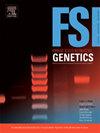Characterizing stutter in single cells and the impact on multi-cell analysis
IF 3.1
2区 医学
Q2 GENETICS & HEREDITY
引用次数: 0
Abstract
Short tandem repeat analysis is a robust and reliable DNA analysis technique that aids in source identification of a biological sample. However, the interpretation, particularly when DNA mixtures are present at low levels, can be complicated by the presence of PCR artifacts most commonly referred to as stutter. The presence of stutter products can increase the difficulty of interpretation in DNA mixtures as well as low-level DNA samples down to a single cell. Stutter product formation is stochastic in nature and although methods exist that can estimate the magnitude of stutter product formation, it still is not well understood. With the increased sensitivity of forensic DNA analyses, it has become possible to obtain interpretable DNA profiles from as low as 6.6 pg of DNA, or a single human diploid cell. However, this presents an interpretational challenge because the stutter in these low-level DNA samples might stray from the expected patterns observed in high-level DNA samples. Therefore, this project focuses on characterizing stutter in single cell samples to help generate a deeper understanding of stutter and provide a guide for detecting and evaluating stutter in low-level samples. Stutter analysis was performed using data generated from 180 single cells isolated with the DEPArrayTM NxT, amplified using the PowerPlex Fusion 6 C amplification kit at 29 or 30 cycles. Stutter was successfully characterized in single cells and stutter percentages were highly elevated compared to high-level samples where the variance increased as the number of cells being analyzed decreased leading to potential high stutter at low DNA levels. Using empirical and simulated (resampled) data, this study also reinforces historically relevant patterns in stutter product formation and demonstrates the relative differences in stutter in n-1, n-2 and n + 1 stutter product formation in simple, complex and compound repeats.
单细胞口吃的特征及其对多细胞分析的影响。
短串联重复序列分析是一种可靠的DNA分析技术,有助于生物样品的来源鉴定。然而,解释,特别是当DNA混合物存在于低水平时,可能会由于PCR伪影的存在而变得复杂,最常见的是被称为口吃。在DNA混合物以及低水平DNA样本中,口吃产物的存在会增加解释的难度,直至单个细胞。口吃产物的形成在本质上是随机的,虽然有方法可以估计口吃产物形成的大小,但它仍然没有得到很好的理解。随着法医DNA分析灵敏度的提高,从低至6.6 pg的DNA或单个人类二倍体细胞中获得可解释的DNA图谱已经成为可能。然而,这提出了一个解释上的挑战,因为这些低水平DNA样本中的口吃可能偏离在高水平DNA样本中观察到的预期模式。因此,本项目将重点研究单细胞样本中的口吃特征,以加深对口吃的认识,并为低水平样本中的口吃检测和评估提供指导。使用DEPArrayTM NxT分离的180个单细胞产生的数据进行口吃分析,使用PowerPlex Fusion 6 C扩增试剂盒在29或30个周期进行扩增。与高水平样本相比,在高水平样本中,随着分析细胞数量的减少,差异会增加,从而导致在低DNA水平下潜在的高口吃。利用经验和模拟(重采样)数据,本研究还强化了口吃产物形成的历史相关模式,并证明了简单、复杂和复合重复中n-1、n-2和n + 1口吃产物形成的相对差异。
本文章由计算机程序翻译,如有差异,请以英文原文为准。
求助全文
约1分钟内获得全文
求助全文
来源期刊
CiteScore
7.50
自引率
32.30%
发文量
132
审稿时长
11.3 weeks
期刊介绍:
Forensic Science International: Genetics is the premier journal in the field of Forensic Genetics. This branch of Forensic Science can be defined as the application of genetics to human and non-human material (in the sense of a science with the purpose of studying inherited characteristics for the analysis of inter- and intra-specific variations in populations) for the resolution of legal conflicts.
The scope of the journal includes:
Forensic applications of human polymorphism.
Testing of paternity and other family relationships, immigration cases, typing of biological stains and tissues from criminal casework, identification of human remains by DNA testing methodologies.
Description of human polymorphisms of forensic interest, with special interest in DNA polymorphisms.
Autosomal DNA polymorphisms, mini- and microsatellites (or short tandem repeats, STRs), single nucleotide polymorphisms (SNPs), X and Y chromosome polymorphisms, mtDNA polymorphisms, and any other type of DNA variation with potential forensic applications.
Non-human DNA polymorphisms for crime scene investigation.
Population genetics of human polymorphisms of forensic interest.
Population data, especially from DNA polymorphisms of interest for the solution of forensic problems.
DNA typing methodologies and strategies.
Biostatistical methods in forensic genetics.
Evaluation of DNA evidence in forensic problems (such as paternity or immigration cases, criminal casework, identification), classical and new statistical approaches.
Standards in forensic genetics.
Recommendations of regulatory bodies concerning methods, markers, interpretation or strategies or proposals for procedural or technical standards.
Quality control.
Quality control and quality assurance strategies, proficiency testing for DNA typing methodologies.
Criminal DNA databases.
Technical, legal and statistical issues.
General ethical and legal issues related to forensic genetics.

 求助内容:
求助内容: 应助结果提醒方式:
应助结果提醒方式:


